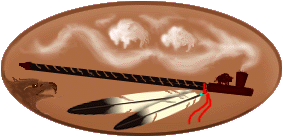

No rite was more widely practiced by Native Americans than smoking. When an Indian lit a mixture of tobacco and various aromatic herbs (called Kinnikinnick) in the stone bowl of his pipe, his intent was often deeply serious. The smoke that he exhaled was seen as a breath of prayer, and the pipe itself was regarded as an intimate channel of communication to the spirit world. Pipes were also used to sanctify communication between men. An early French fur trapper noted that pipe smoking was, "the introductory step to all important affairs, and no business can be entered upon with these people before the ceremony of smoking is over."
Ceremonial pipes were the personal property of a chief, medicine man, or warrior. They were smoked according to a grave and precise ritual to pledge an oath or ratify a treaty; which inspired the white man's phrase, "peace pipe."
The pipes were also used as passports when traveling and for conciliation in even the most private disputes. If a brave ran off with someone else's wife, etiquette decreed that he send an old man to the husband bearing a pipe. If the husband smoked the offering, it meant that he would not take revenge on the lovers. Many men owned an unadorned everyday pipe, because smoking was also a casual habit. But the older men sometimes felt obliged to warn the young warriors against excessive smoking; it could cut their wind and thus reduce their stamina in a battle.
Careful patient labor went into the making of a ceremonial pipe...and a good one might be worth the price of a horse or several buffalo robes. Pipe bowls were shaped from soft stone of varying colors, with red considered the most beautiful. The carving of pipe bowls was usually done by specialists. Using metal tools (obtained from Europeans) these skilled craftsmen could fashion the stone into images such as a horse in full gallop, or they could execute fine details of relief. After they had carved a bowl they would smooth and polish its surfaces by rubbing them with an abrasive variety of water grass.
The pipe stems were made of gray ash, willow, or cottonwood. All of these woods have soft, pithy centers that the pipe maker either hollowed out after having split the stem in half or burned out by using a hardwood stick or, later, a piece of heated wire. Although some of the tobacco smoked by the Indians grew wild, various tribes cultivated it in order to have a predictable supply available, and to be able to trade it to other tribes. Both the planting of seeds and the harvesting of tobacco leaves were occasions for ritualistic prayers and dances.

